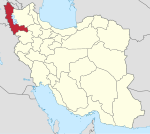Salmas
Salmas
سلماس | |
|---|---|
city | |
 Tomb of Salmas | |
| Country | |
| Province | West Azerbaijan |
| County | Salmas |
| Bakhsh | Central |
| Population (2006) | |
| • Total | 79,560 |
| Time zone | UTC+3:30 (IRST) |
| • Summer (DST) | UTC+4:30 (IRDT) |
Salmas (Persian: سلماس, Azerbaijani: ﺩﻳﻠﻤﻘﺎﻥ , سالماس,Sālmās, Dılmaqan; also Romanized as Salmās and Salamas; formerly, Delemon, Dīlmagān, Dīlman, Shahpoor, Shāhpūr, and Shapur)[1] is a city in and the capital of Salmas County, West Azerbaijan Province, Iran. It is located close to the Turkish border. At the 2006 census, its population was 79,560, in 19,806 families.[2] The majority of the population is composed of Azerbaijanis, as well as Assyrian, Armenian, Persian Jewish,[3] Kurdish[4] and ethnic Persian minorities.
History
Early mention of Salmas was made in 1281, when its Assyrian bishop made the trip to the consecration of the Assyrian Church of the East patriarch Yaballaha in Baghdad.[5]
In the Battle of Salmas on 17–18 September 1429, the Kara Koyunlu were defeated by Shah Rukh who was consolidating Timurid holdings west of Lake Urmia.[6] However, the area was retaken by the Kara Koyunlu in 1447 after the death of Shah Rukh.
Mar Shimun, the Patriarch of the Assyrian Church of the East was murdered by the Kurdish chieftain Simko Shikak in Salmas in March 1918.[7][8][9]
Around the advent of the 1910s, Imperial Russia started to station infantry and Cossacks in Salmas.[10] The Russians retreated at the time of Enver Pasha's offensive in the Iran-Caucasus region, but returned in early 1916, and stayed up to the wake of the Russian Revolution.[10] Part of the Assyrian Genocide took place in Salmas and the surrounding region at the hands of the Ottoman Army and loyal Kurdish irregulars. This followed initially successful Assyrian military campaigns against the Ottomans and their Kurdish allies.[citation needed]
Notable people
- Stepanos V of Salmast (d. 1567) – Catholicos of the Armenian Apostolic Church
- Yohannan Gabriel (1758–1833) – Catholic bishop of Salmas
- Nicholas I Zaya (d. 1855) – Catholic patriarch
- Raffi (1835–1888) – novelist
- Paul Bedjan (1838–1920) – Catholic priest and orientalist
- Abraham Guloyan (1893–1983) - politician
- Murad Kostanyan (1902–1989) – actor
- Ardeshir Ovanessian (c. 1905–1990) – Communist leader
- Jafar Salmasi (1918–2000) – weightlifter
- Emmanuel Agassi (b. 1930) – boxer and father of André Agassi
- Aliakbar Aghaei Moghanjoei (b. 1947) – politician
- Hadi Asghari (b. 1981) – football player
Gallery
-
Overall View of Imam St. and Shahrdari Sq.
-
Islamic Republic Blvd., Near Panahi Technical School
-
Khan Takhti-Rd near Salmas
-
The Haftvan Church
-
Salmas
See also
References
- ^ Salmas can be found at GEOnet Names Server, at this link, by opening the Advanced Search box, entering "-3082081" in the "Unique Feature Id" form, and clicking on "Search Database".
- ^ "Census of the Islamic Republic of Iran, 1385 (2006)" (Excel). Statistical Center of Iran. Archived from the original on 20 September 2011.
- ^ http://thegraduatesocietyla.org/images/author-padia-others.pdf
- ^ http://salmas.ir/HomePage.aspx?TabID=4626&Site=DouranPortal&Lang=fa-IR
- ^ Houtsma, M. Th. et al. (1993 reprint) "Salmas" E. J. Brill's First Encyclopaedia of Islam, 1913–1936 Volume 4, E.J. Brill, New York, page 118, ISBN 90-04-09796-1
- ^ Houtsma, M. Th. et al. (1993 reprint) "Tabrīz" E. J. Brill's First Encyclopaedia of Islam, 1913–1936 Volume 4, E.J. Brill, New York, page 588, ISBN 90-04-09796-1
- ^ Houtsma, M. Th. et al. (1993 reprint) "Shakāk" E. J. Brill's First Encyclopaedia of Islam, 1913–1936 Volume 4, E.J. Brill, New York, page 290, ISBN 90-04-09796-1
- ^ O'Shea, Maria T. (2004) "Trapped Between the Map and Reality: Geography and Perceptions of Kurdistan Routledge, New York, page 100, ISBN 0-415-94766-9
- ^ Nisan, Mordechai (2002) Minorities in the Middle East: A History of Struggle and Self-Expression (2nd edition) McFarland, Jefferson, North Carolina, page 187, ISBN 0-7864-1375-1
- ^ a b Atabaki 2006, p. 70.
Sources
- Atabaki, Touraj (2006). Iran and the First World War: Battleground of the Great Powers. I.B.Tauris. ISBN 978-1860649646.
{{cite book}}: Invalid|ref=harv(help)
External links
- Salmas ancient location
- Salmas famous people
- Salmas, By C.E. Bosworth, Encyclopaedia of Islam.
- "Salmas Map – Satellite Images of Salmas", Maplandia







